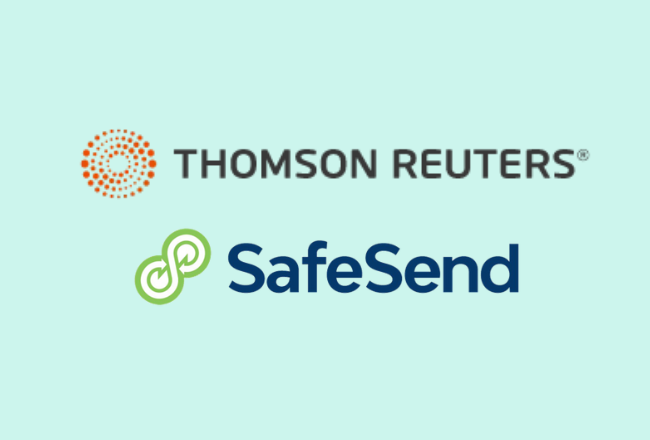
The Accountant's Guide to Secure File Sharing
The average accountant’s office used to be buried under paper, killing thousands of trees every year to file returns and comply with document-retention regulations.
Going “paperless” is understandably appealing, but in the age of multibillion-dollar cybercrime, security is a real issue. A lot of paper in an accountant’s filing cabinet has sensitive information on it. A data break could be personally disastrous for the client and professionally disastrous for the accountant.
Secure file sharing software solutions like SmartVault close that critical gap, enabling accountant offices to simplify, cut costs, and save trees … all the while maintaining data security and even enhancing the client experience in the process!
What is Secure File Sharing?
Secure file sharing is the practice of sharing files between parties in such a way that the data or content within the files remains protected from access, theft, or alteration by unauthorized parties.
As such, security measures are used to maintain the integrity, privacy, and accessibility of files during the process of storing and/or transferring them. Digitally, this involves:
- Encryption. Encrypted files cannot be read without an encryption key. Without the key, a file that gets intercepted or stolen will simply be random gibberish.
- Access Controls. Passwords, permissions, and credentials that specify who is authorized to access what.
- Secure Transfer Protocols. Examples include HTTPS, SFTP, and FTPS (the “S” in each case standing for “secure.”)
- Audit Trails. A record of every action and interaction with the file, so anomalies can be spotted.
- Data Integrity Checks. Common examples include checksums and hashes. If the file gets altered, so does the checksum value.
- Endpoint Security. Hardware and software security for the computers and mobile devices that interact with the files.
- Data Loss Prevention. Tools that keep data in the network, safe from loss or theft.
Why Are Email and Other Transfer Methods Unsecure?
So what about email? Or other methods of file transfer? These methods are considered “unsecure” methods of file transfer for several reasons:
- Lack of Encryption. Normal email is not encrypted by default. Even if you take extra steps to encrypt it, the metadata (sender, recipient, subject line) may be unencrypted, giving away sensitive data to interlopers.
- Susceptible to Malware and Phishing. It’s easy to spoof an email, so they are common targets for phishing, including “attack” links that download malware when clicked.
- No Control Over Sent Data. Once an email has been sent, you can’t revoke access to the contents from the recipient. Other file-sharing methods make it similarly difficult to revoke access completely, especially if the recipient has had time to make a copy.
- Limited Ability to Track or Audit. With email and other file-sharing techniques, there often is no default record of all the actions and interactions with the file, making it hard to trace security breaches to their source.
Benefits of Secure File Sharing for Accounting Firms
Improved Security and Compliance
Accountants deal with sensitive information every day, including US Social Security numbers, UK National Insurance numbers, contact information, bank account numbers, and much more. Data breaches of accounting firms can be disastrous. Secure file sharing reduces that risk, offering both the client and the accountant peace of mind.
Additionally, secure file transfer and storage helps accounting firms comply with various regulations that require accountants to handle sensitive client information with care. US examples include the Sarbanes-Oxley Act (SOX), Gramm-Leach-Bliley Act (GLBA), and rules set by the IRS and FTC like the Written Information Security Plan (WISP).
UK examples include the Data Protection Act 2018 (DPA 2018), General Data Protection Regulation (GDPR), and Financial Conduct Authority (FCA) Regulations.
Failure to comply can result in hefty penalties. A good secure file sharing solution can guard accounting firms against that outcome.
Better Client Experience
In addition to improved security, secure file sharing solutions can offer a better client experience. No more labyrinthine email chains where the client can never find their documents or essential information. A secure file sharing solution can make client interactions as easy as they are secure.
For example, SmartVault has an online client portal integrated with its document management system. Accountants can request a list of documents from their clients, who then upload the required documents securely in the client portal. This allows clients to review, eSign, share, and download documents from any location, as the client portal is 100% in the Cloud.
Increased Efficiency and Productivity
The right secure file sharing system can act as a one-stop shop for any number of functions, including client relationship management, paperless document management, eSignatures, and email capture. Solutions like SmartVault also include integrations and automation to create seamless, automated workflows, freeing up resources to allocate more effectively and efficiently.
Case Studies of Secure File Sharing Success for Accountants
Green & Sklarz
Before tax attorney Eric Green, Managing Partner of Green & Sklarz, implemented SmartVault, his team spent three to four hours (or $450-$600) opening a new client folder. Most of this time was wasted going through the new client’s submitted documents – typically a 300+ page PDF file of unorganized pages.
“Once we implemented SmartVault, we cut nearly two hours off the set-up and review of the PDF documents,” Eric said.
How? They’d send the client links to the SmartVault portal, and they’d upload the documents directly into the correct folders – all organized for them. That $300 of billable time saved, multiplied by the ten new files they’re opening a week, means about $150,000 of saved time (billable time that can be spent on collectible client work).
Zweig & Associates
To create a secure, paperless document management system for their 5,000+ clients and 3,500+ tax returns, Zweig & Associates adopted SmartVault. Their worldwide client base now securely upload their documents directly to the Cloud rather than the cumbersome and paper-intensive process of mailing them in.
“It makes our process of receiving and tracking client information much more efficient,” Document Manager Michell Baker said. “It’s an efficient, easy-to-use way to centralize business and client files. Our clients appreciate the secure storage and document transfer capabilities.”
Paolini Financial Group
For Paolini Financial Group, serving 550 clients, adopting SmartVault not only made operations simpler — they also realized immediate cost savings.
“SmartVault allowed us to eliminate our server and full-time IT service, saving around $1,500 per month,” firm President Robert J. Paolini said.
In addition to document security, the easy eSignature functionality was a hit. “Getting e-signatures from clients is so easy,” Paolini said. “Our clients appreciate the security of the SmartVault client portal for exchanging sensitive documents.”
One Stop Tax Service & Professional Help
To comply with document retention regulations, One Stop Tax Service & Professional Help used to keep paper copies of all 880 clients’ records in file cabinets. This led to misfiled documents and long hours wasted searching through file folders.
With SmartVault, every document is scanned, saved to the Cloud, and tagged for easy recall. “All data is secure through SmartVault and clients have access to their own files whenever needed,” staff tax preparer Dania Amezcua said. “The SmartVault mobile app is my favorite feature. I can access client documents from anywhere, even when I’m on vacation.”
Best Practices for Secure File Sharing
Establish Formal Processes and Permissions
Put in writing who will have access to what within the secure file sharing ecosystem. Segment by role, seniority, necessity, and security clearance.
Prioritize Client Experience
Yes, a good secure file sharing solution can make life easier for accountants and their support staff, but think first and foremost about how the client will experience the solution. Selecting the solution that provides the best client experience will pay off in the longevity of the solution as an asset to the firm.
Maintain Tight Security Controls
Set your security controls and don’t deviate from them. No exceptions. Continually educate and familiarize your team with security standards and practices, and provide resources to clients on how they can contribute to the security of the ecosystem, as well as the scams and attacks they might encounter.
Enable Integrations and Automation
Whatever applications you cannot eliminate from your tech stack with the secure file sharing solution, integrate with the solution so they can interact seamlessly with each other. Automate workflows with in-app automation or external “zap” automations so as many critical tasks as possible happen instantaneously without the need for human resources or the possibility of human error.
Monitor and Optimize Continually
Don’t just set it and forget it. Periodically audit the operation and security of the solution to ensure optimal performance.
How to Implement Secure File Sharing at Your Accounting Firm
Choosing a Secure File Sharing Software Solution
With many secure file sharing solutions on the market, picking the right one can be challenging. Here’s how to go about selecting the right solution for you:
- Identify Your Requirements. Make a list of your current file sharing and document management needs. What happens to every document your firm touches? What is each stage in the lifestyle of each document?
- Evaluate Your Compliance Needs. What regulations must you comply with that apply to secure file and document management? What standards will you be held to to avoid a fine or penalty from various governing bodies?
- Evaluate The Security Features of Each Solution. What level of encryption do they offer? What transfer protocols? How are access controls established? What audit trails are kept? What data integrity checks are in place? Do they rise to the level of your regulatory burden and your individual firm needs?
- Check Usability and Integration. Can the software solution be used with the current level of technical knowledge on your team, or would you have to upskill? Does it integrate with other software and SaaS solutions you need to do your business and can’t replace with the solution?
- Look At Scalability and Flexibility. Can the solution grow with your firm? What would happen to the user experience and investment if your firm doubled in size? 10x’ed in size?
- Research Vendor Reputability and Support. Check into the vendor. How long have they been in business? Do they have a good reputation with watchdog groups like the BBB? Have they or the founders launched other successful solutions? What is their support infrastructure like? Do they have a support phone number? Live chat support? Fast email response? Will they handle support tickets from your clients as well?
- Test The Solution. Request a demo, preferably a guided demo. Play around with both the backend experience and the client experience so you know what you’re signing up your current and future clients for.
- Consider Your Budget. If several solutions make it to the finish line, budget is a great tie breaker. Which solution fits best with your budget? If you’re sacrificing features to control costs, can you live without those features or acquire them in a more cost-effective way?
Tips for Rolling Out the Software Solution
- Create a Written Rollout Plan. Set target dates, milestones, and KPIs.
- Get Early Stakeholder Buyin. This includes key staff members and your client base at large. Let them know of the change that is coming, and get them excited about it!
- Provide Robust Training. If you have prioritized client experience, onboarding clients should be relatively easy. For the back office, provide access to comprehensive training.
- Maintain Communication. Keep an open-door policy with team members and clients regarding the new solution. It’s important to get their feedback and continuously improve.
- Monitor Results. Track KPIs and solicit user feedback.
- Provide Support. Make sure both front-end and back-end users have access to fast, priority support.
- Disseminate Security Policies. Write down any back-end security policies, make them available to the team, and drill them as necessary.
- Analyze and Adapt. Be prepared to adjust and change course based on the feedback and KPIs that come back to you.
SmartVault: Secure File Sharing for Accounting Firms
Secure file sharing solutions can benefit accounting firms for many reasons. In addition to furnishing peace of mind and regulatory compliance through secure document management, they reduce the office’s dependence on paper, cut costs, and automate processes, as well as provide clients with a convenient, seamless user experience.
SmartVault provides all of that and much more — industry-best customer and client support from one of the most trusted names in the digital security business. Contact us to request a demo of SmartVault, and see what it can do for your firm!




